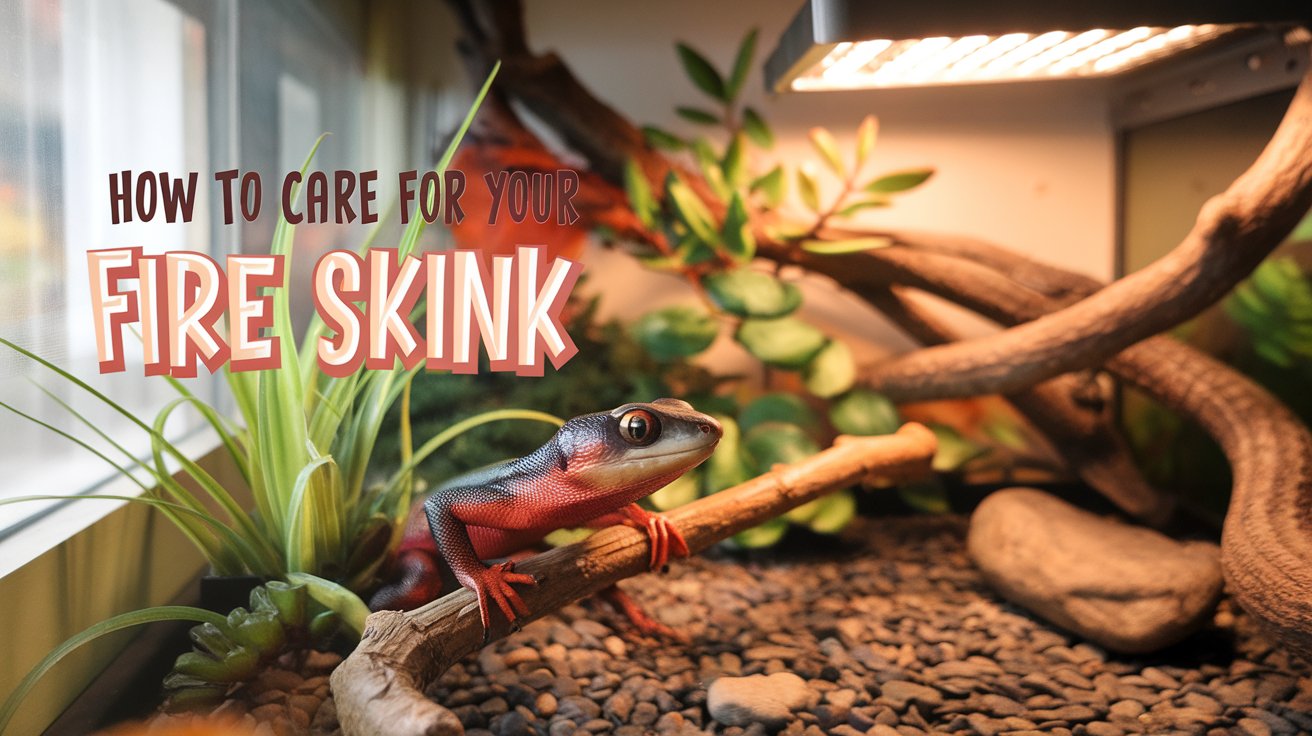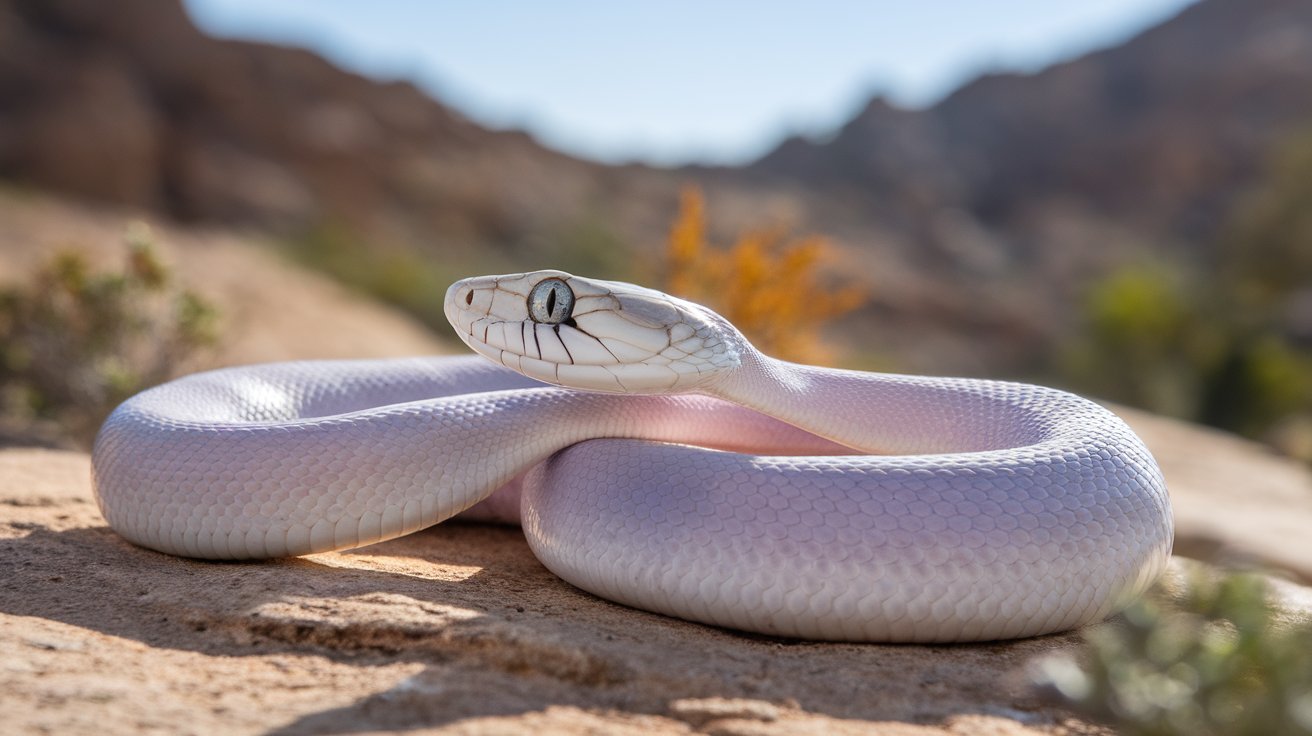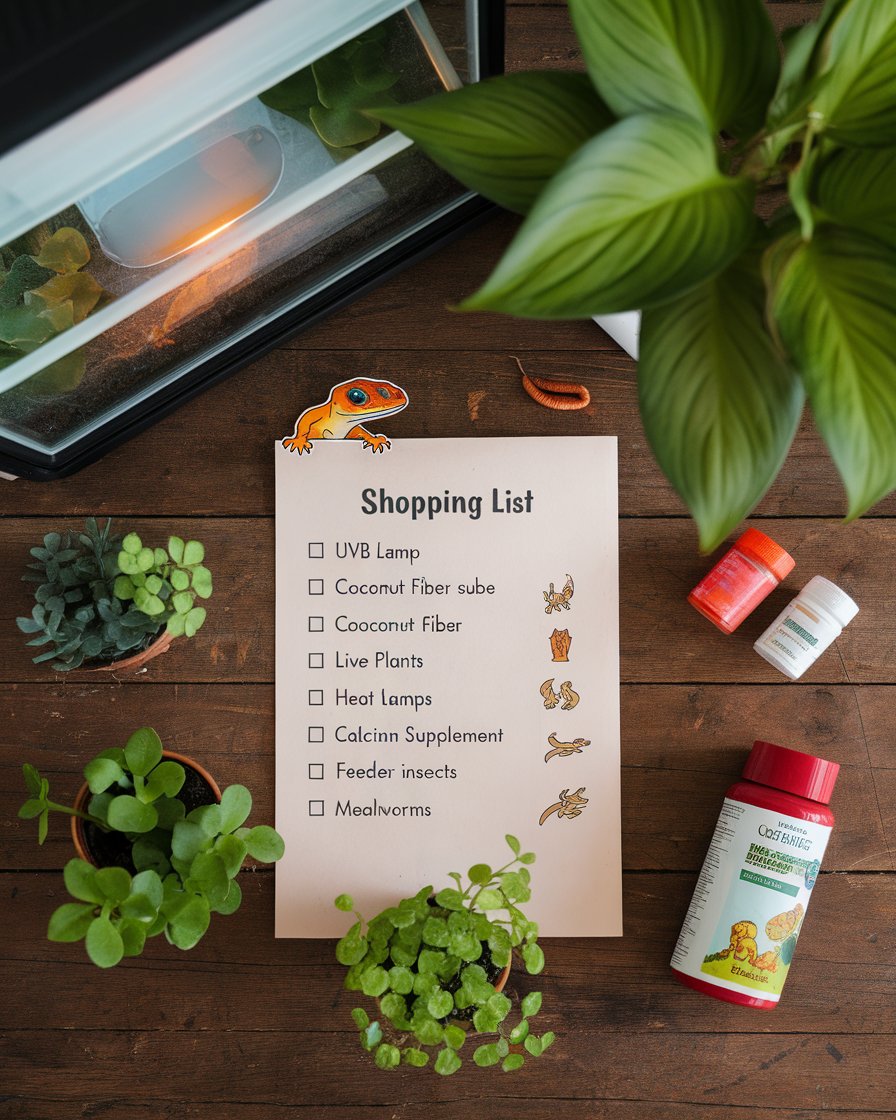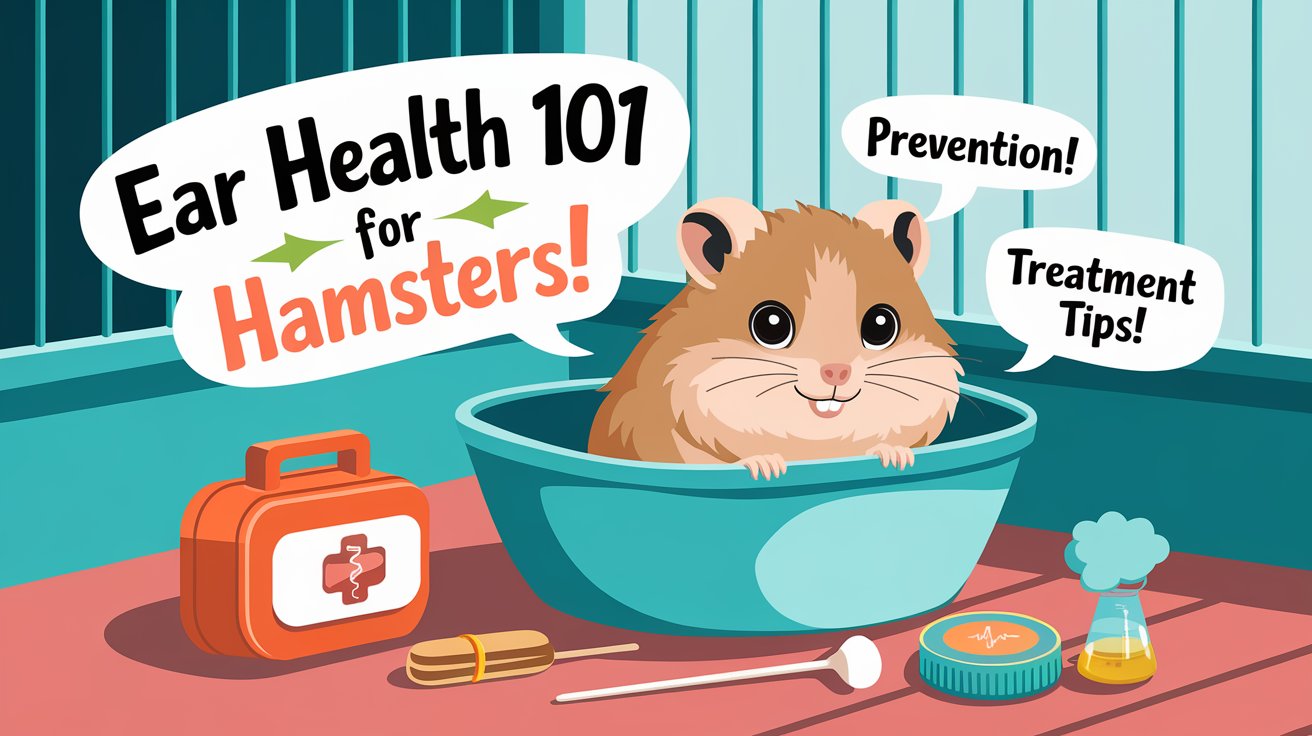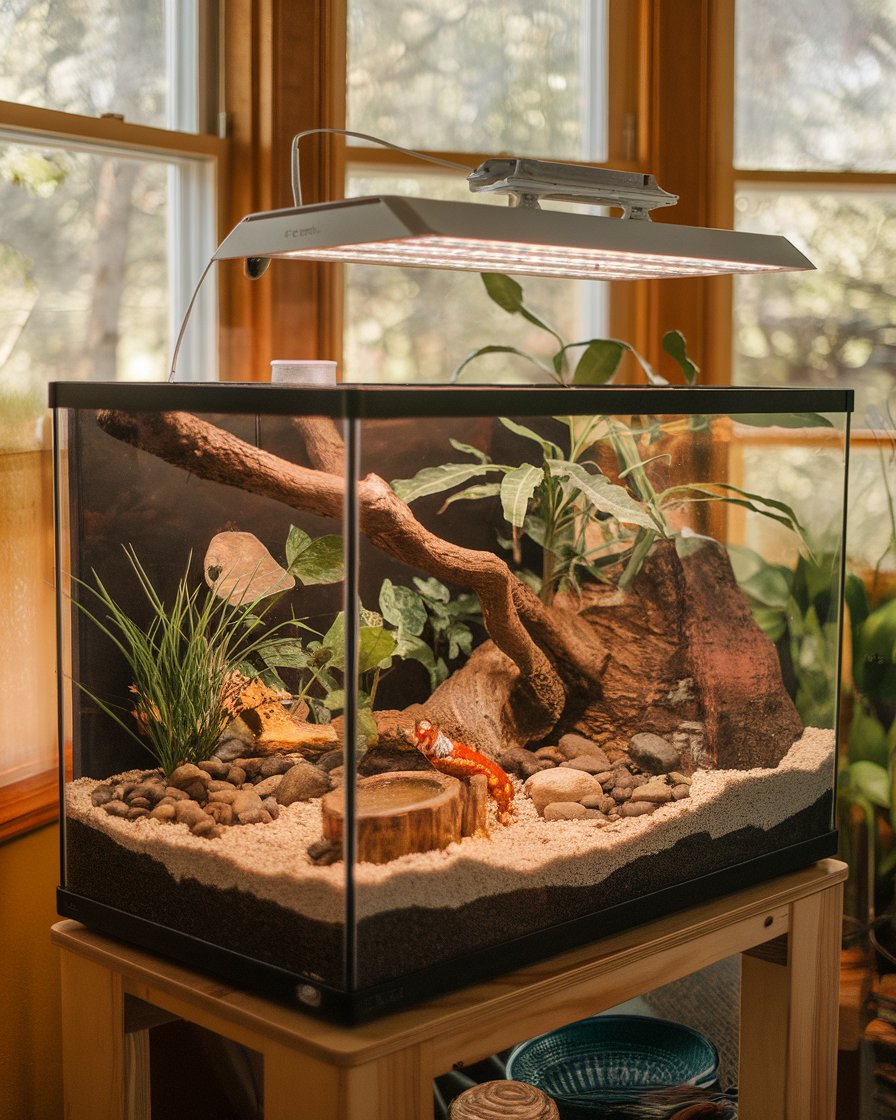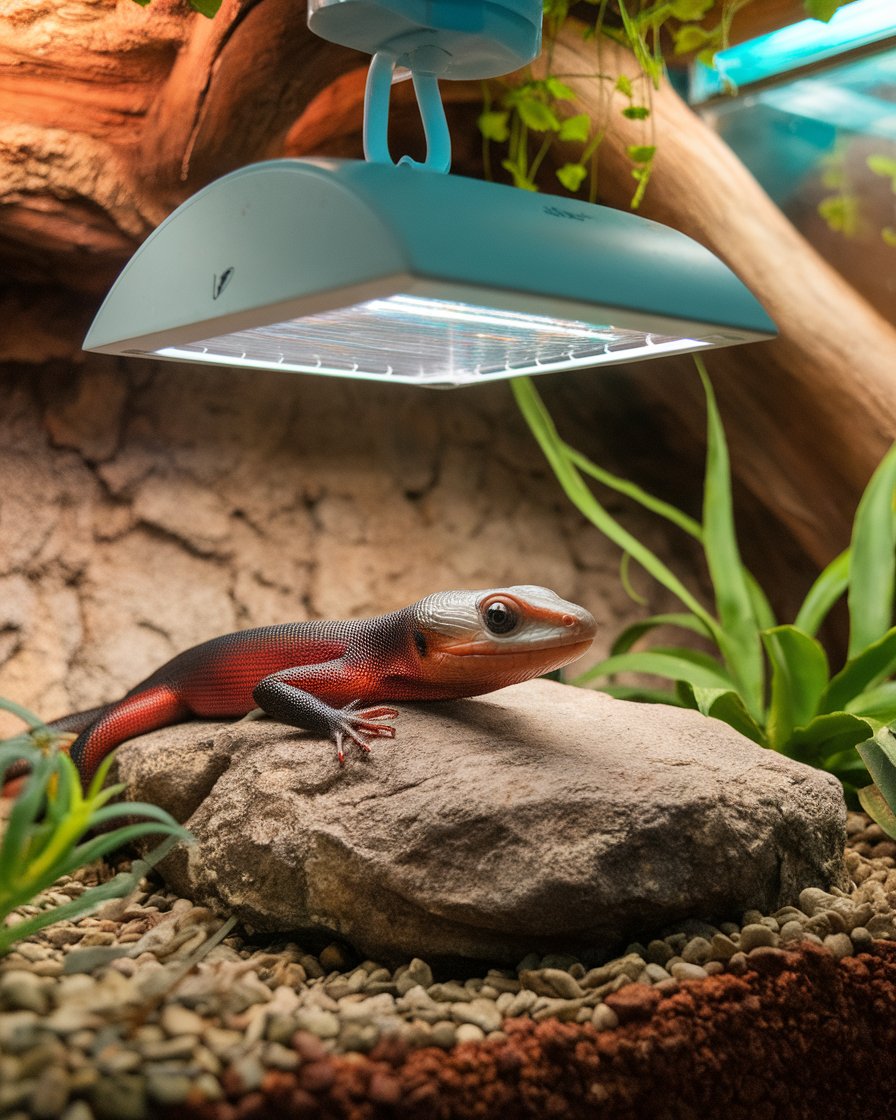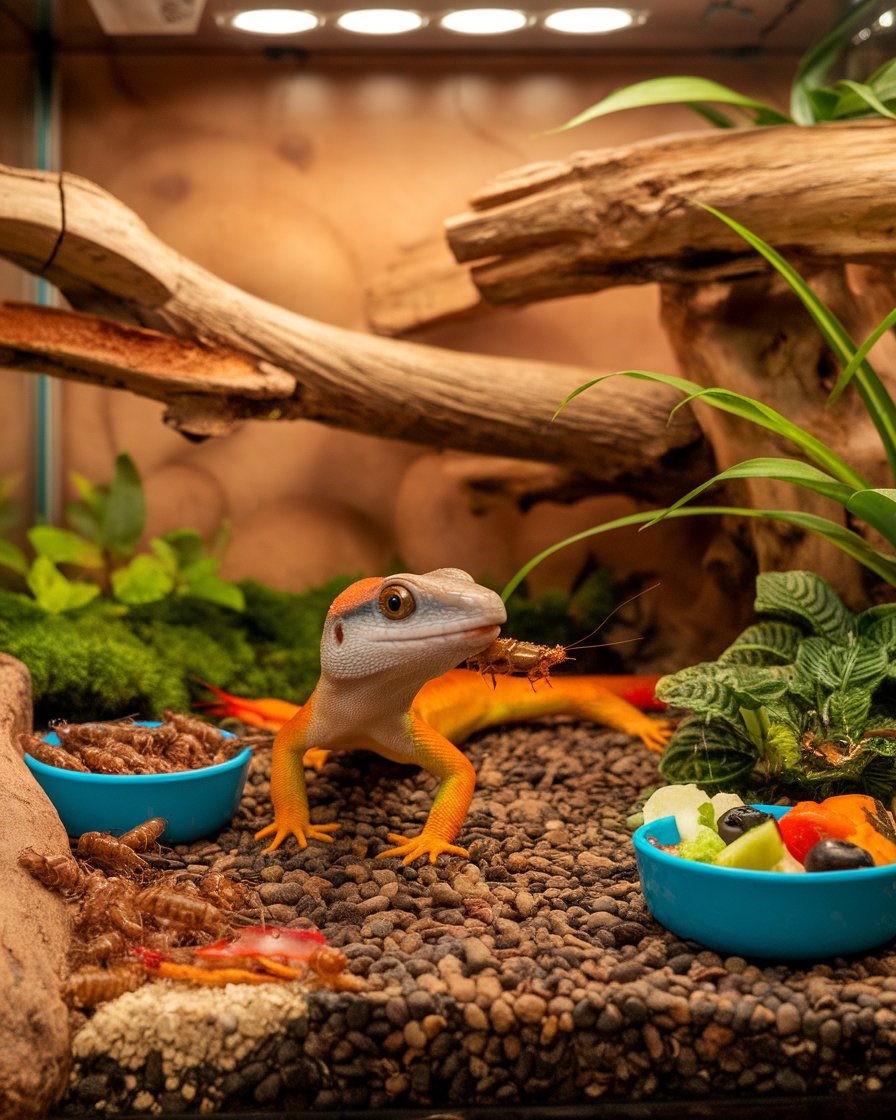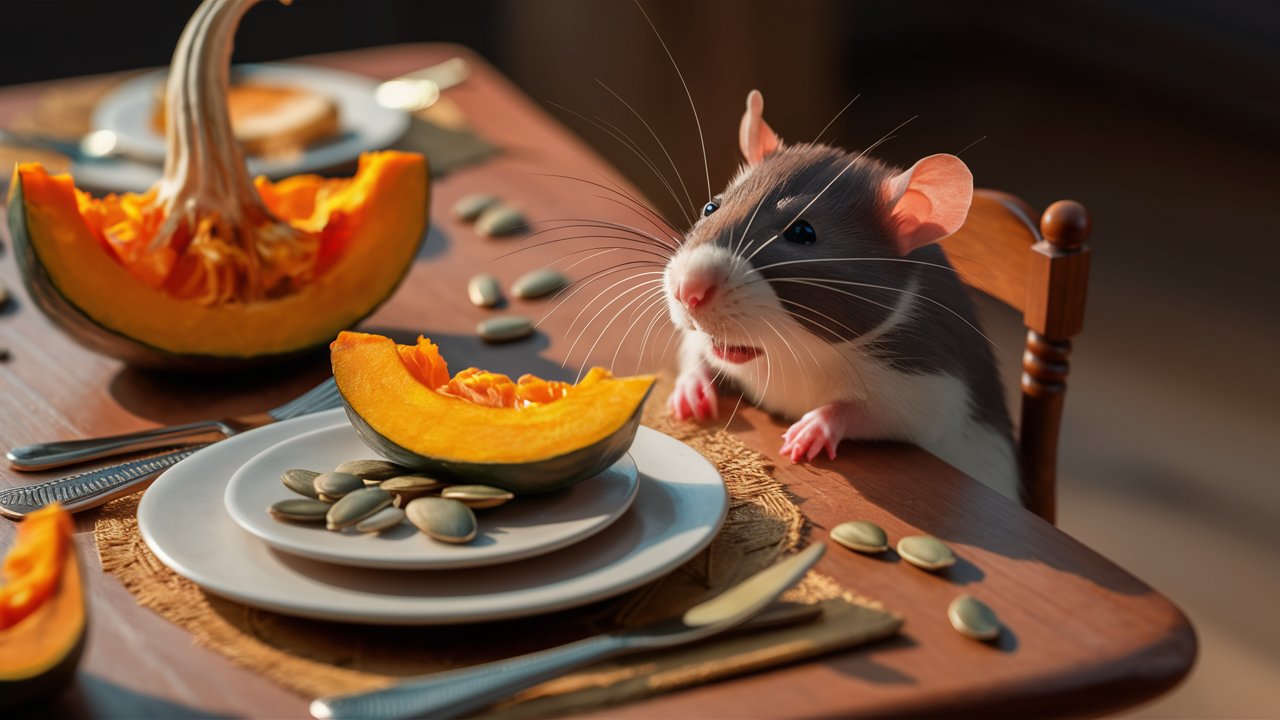Introduction
When preparing to care for a fire skink, it’s essential to understand the specific needs of these fascinating reptiles. Fire skinks thrive best in environments that mimic their natural habitat, which includes maintaining average humidity levels between 60-70% and providing the appropriate UVB lighting. Whether you’re housing a single skink or multiple, ensuring the proper enclosure size is crucial. A fire skink terrarium should be at least 36”L x 18”W x 18”H, with ample room for the skink to hide, burrow, and explore. Additionally, any contaminated substrate should be completely replaced every few months to ensure a clean and healthy environment.
A well-balanced diet plays a significant role in fire skink care. Feeder insects should be provided daily, and adults should be fed every day or every other day, depending on their size and activity level. It’s also important to dust insects with calcium supplements to prevent nutrient deficiencies. This care guide can help ensure that your fire skink thrives in captivity.
Key Takeaways
-
Fire skinks thrive in environments with average humidity levels between 60-70% and require UVB lighting for optimal health.
-
A terrarium size of at least 36”L x 18”W x 18”H is necessary for housing a single fire skink, with larger enclosures being preferable.
-
Fire skinks benefit from a well-lit enclosure with a balanced light schedule that mimics their natural habitat.
-
A varied diet of feeder insects, along with calcium and vitamin supplements, is crucial for the health and longevity of fire skinks.
-
It’s important to replace contaminated substrate every few months to ensure a clean and healthy enclosure environment.
-
Fire skinks should be fed daily or every other day, with attention to prey size and regular dusting of insects with calcium supplements.
Fire Skink Shopping List
When preparing to bring home a fire skink, it’s important to have a detailed shopping list to ensure all their needs are met. These lizards, native to West Africa, thrive in environments that mimic their natural habitat. From setting up the right enclosure to maintaining proper humidity levels, fire skink care requires attention to detail. Be sure to provide a spacious terrarium, heating and UVB lighting, and enrichment items. Fire skinks are diurnal, meaning they are active during the day, so keeping a well-lit and warm environment is key to ensuring their well-being. Investing in quality equipment will help maintain a happy and healthy pet fire skink.
How To Fire Skink Care Sheet: Your Reptile Care Guide
1. Proper Enclosure Setup
For a fire skink to thrive, the enclosure size should be at least 36”L x 18”W x 18”H, but larger is better. The terrarium should allow enough space for the skink to hide, burrow, and climb. A front-opening terrarium is recommended for ease of access. Make sure the enclosure maintains a balanced environment with UVB lighting, warmth, and humidity levels between 60-70%. This setup will promote healthy behavior and provide a comfortable living space.
2. Essential Heating and Lighting
Maintaining the right temperature and lighting is key to fire skink care. UVB lighting is critical for calcium absorption and bone health, while heat lamps help maintain a basking area around 90°F. Make sure the enclosure’s cool side doesn’t drop below 75°F. It’s important to replace UVB bulbs every 12 months to ensure effectiveness. Regularly check temperatures with a probe to keep the basking area from getting too cool.
3. Substrate and Environmental Enrichment
Use a substrate that allows your fire skink to burrow, such as coconut fiber or topsoil. This helps replicate their natural behavior and keeps them active. Be sure to replace the substrate every 3-4 months to prevent contamination. Adding environmental enrichment, such as live plants, hiding spots, and climbing structures, encourages exploration and natural instincts. Keeping the substrate clean and enriched ensures a happy, healthy skink.
4. Balanced Diet and Feeding Schedule
Fire skinks thrive on a varied diet primarily composed of feeder insects like crickets, mealworms, and discoid roaches. Juveniles should be fed daily, while adults can be fed every other day. Insects should be dusted with calcium powder at least once a week to prevent nutrient deficiencies. It’s crucial to offer appropriately sized prey to avoid choking hazards. Occasional fruits and vegetables can be added to provide additional nutrients.
5. Humidity and Hydration
Maintaining the right humidity levels in your fire skink’s enclosure is critical for their skin health and overall well-being. Humidity should remain between 60-70%, and it’s helpful to include a shallow water dish for hydration. Mist the enclosure daily to maintain moisture, especially during shedding periods. Ensuring proper hydration and humidity levels helps prevent respiratory issues and keeps your skink in optimal condition.
6. Routine Care and Maintenance
Routine care is essential for your fire skink’s longevity. Make sure the terrarium is cleaned regularly, and the substrate is replaced every few months. Monitor the enclosure for temperature, humidity, and cleanliness. Always provide fresh water and inspect your fire skink for signs of health issues, such as changes in activity or eating habits. With proper care, fire skinks can live up to 15-20 years.
Recommended Terrarium Size
When it comes to housing a single fire skink, a terrarium size of at least 36”L x 18”W x 18”H is recommended. This space allows your pet to roam, explore, and exhibit natural behaviors like burrowing. Larger enclosures are always better, as they give fire skinks room to be quite active. Be sure to include ample space for hiding spots and climbing structures to enrich their environment. Fire skinks are typically solitary, so housing multiple skinks in the same terrarium is not recommended. Ensuring the right enclosure size helps maintain appropriate UVB lighting and humidity levels, which are vital for their health.
Critical Equipment and Supplies
A proper terrarium setup is essential for the overall health and longevity of your fire skink. Key supplies include a front-opening terrarium, heat lamps, and a UVB light source. Fire skinks need UVB lighting to absorb calcium and maintain good bone health. Additionally, maintaining humidity levels between 60-70% is crucial for their skin and respiratory health. Use a substrate that allows for burrowing, such as coconut fiber, and replace it every 3-4 months to avoid contamination. Adding live plants can also enhance their environment and help maintain proper humidity. With the right care, fire skinks can live up to 15-20 years.
Fire Skink Enclosure Requirements
Providing the right enclosure for your fire skink is essential to its well-being. Fire skinks, known for their active and curious nature, need a space that mimics their natural environment. The terrarium should have a balance of warmth, humidity, and light to create a habitat that promotes healthy behavior. Fire skinks can survive without UVB lighting temporarily, but long-term exposure to UVB is important for their bone health and overall good care. It’s also vital to maintain average humidity levels between 60-70% to prevent skin and respiratory issues. A properly sized and equipped terrarium will ensure your fire skink thrives.
Case Study: The Impact of Enclosure Size and UVB Lighting on Fire Skink Health
In a 2018 study published by a reptile care research group, the relationship between enclosure size and UVB lighting on fire skink health was analyzed. The study involved two groups of fire skinks housed in different sized enclosures. Group A was kept in enclosures measuring 24”L x 18”W x 18”H, while Group B was provided larger enclosures of 36”L x 18”W x 18”H with appropriate UVB lighting. Over a 12-month period, researchers monitored the physical health and behavior of the fire skinks, focusing on their activity levels, bone density, and shedding.
The findings showed that Group B, which had access to UVB lighting and more space, demonstrated healthier bone density and more natural behaviors, such as regular burrowing and climbing. Meanwhile, Group A exhibited signs of lower activity levels and metabolic bone issues due to lack of sufficient UVB exposure. This study highlights the importance of providing ample enclosure space and proper UVB lighting to ensure the long-term health of fire skinks.
Size and Layout
The size of the terrarium is crucial when setting up a fire skink enclosure. At a minimum, the enclosure should measure 36”L x 18”W x 18”H for a single skink. However, larger enclosures are always better, as fire skinks are quite active and need plenty of space to move around. Adding hiding spots, such as logs or small caves, allows them to mimic their natural behaviors. Climbing structures and basking surfaces should also be included. The basking area should be kept warm and monitored with a probe to ensure it’s not too cool. This setup provides the best results for their health and activity levels.
Housing Multiple Fire Skinks
While fire skinks are generally solitary reptiles, it is possible to house multiple females in a single enclosure if the tank is large enough to accommodate them comfortably. Fire skinks can become territorial, especially males, so it’s best to avoid placing male skinks together to prevent aggressive behavior and injuries. Ensure that each fire skink has access to hiding spots and their own space within the enclosure to reduce stress. The enclosure should also be large enough to maintain appropriate UVB lighting and humidity levels for all the skinks. Following these guidelines will help create a harmonious living environment for multiple fire skinks.
Lighting and UVB for Fire Skinks
Providing proper lighting, especially UVB, is essential for the long-term health of fire skinks. While these reptiles are technically capable of surviving without UVB, it plays a vital role in their overall well-being. UVB lighting helps fire skinks synthesize vitamin D3, which allows for proper calcium absorption and prevents metabolic bone disease. In addition to UVB, maintaining a consistent light schedule is key for regulating their day and night cycle, promoting normal activity levels. A well-lit enclosure mimics their natural habitat, helping captive-bred fire skinks thrive in captivity. Careful attention to their lighting needs will ensure a healthy and active pet.
Importance of UVB Lighting
UVB lighting is a critical component of fire skink care, as it supports their ability to absorb calcium and maintain strong bones. Without UVB exposure, fire skinks may experience health issues over time, despite receiving calcium supplements. A UVB bulb, such as a T5 HO, should be positioned at the correct height to create a basking area with a UVI (Ultraviolet Index) of 3.0-4.0. It is important to note that UVB is blocked by glass and plastic, so ensure direct exposure. Replacing the bulb every 12 months is crucial to maintain its effectiveness. Providing appropriate UVB will significantly improve the health and longevity of your fire skink.
General Illumination Recommendations
In addition to UVB, general illumination is important for maintaining the fire skink’s natural behavior and biological rhythms. Lights should be on for about 12 hours each day to simulate a proper day-night cycle, which is essential for their activity and feeding patterns. A well-lit enclosure helps your fire skink remain active during the day, as these reptiles are naturally diurnal. Make sure to monitor the basking area to ensure the temperature is not too cool, as fire skinks enjoy warm spots in their terrarium. Combined with a good UVB source, general lighting helps create an optimal environment for fire skinks to thrive.
“Light is essential to life—without it, most creatures would not be able to thrive. It’s more than just visibility, it’s a biological necessity.” – Neil deGrasse Tyson
Feeding and Nutrition
Proper feeding and nutrition are vital for maintaining the health and vitality of fire skinks. These reptiles thrive on a diet primarily composed of insects, which provide the necessary protein and nutrients they need to remain active and healthy. Ensuring a well-balanced diet that includes not only live feeder insects but also occasional fruits and vegetables can make a big difference in your pet’s overall well-being. Fire skinks generally require regular feeding and may also benefit from dietary supplements to prevent deficiencies. Maintaining an appropriate feeding schedule and offering a variety of foods will help your fire skink thrive in captivity.
Diet Variety and Feeding Schedule
Fire skinks are insectivores, meaning their diet should mainly consist of feeder insects like crickets, mealworms, and discoid roaches. It’s best to feed them 5-7 times a week, offering appropriately sized prey to prevent any choking hazards or digestive issues. Juvenile fire skinks may need smaller prey, while adult skinks can handle larger insects. Occasionally, you can introduce fruits and vegetables into their diet for added nutrition, though these should be offered sparingly. Maintaining a consistent feeding schedule helps keep fire skinks active and healthy, ensuring they receive the nutrients needed to support their metabolism and energy levels.
Importance of Supplements
In addition to a varied diet, fire skinks benefit greatly from calcium and vitamin supplements. Since feeder insects alone may not provide all the necessary nutrients, dusting them with calcium at least once a week is recommended. This is particularly important to prevent metabolic bone disease and other calcium-related health issues. Additionally, a multivitamin supplement should be used every two weeks to help fill any gaps in their diet. Maintaining proper UVB lighting alongside these supplements further supports their ability to process these nutrients. With regular supplementation, your fire skink can enjoy a balanced diet that promotes longevity and overall well-being.
Conclusion
Caring for a fire skink requires careful attention to their specific needs, such as maintaining appropriate UVB lighting, humidity levels between 60-70%, and providing a spacious enclosure. Fire skinks are active reptiles that thrive in well-designed environments that mimic their natural habitat, with an enclosure size of at least 36”L x 18”W x 18”H. Regular interaction with your pet fire skink, along with proper enclosure setup, helps them exhibit natural behaviors.
A varied diet is key to their health, so offering a wide range of insects is crucial, along with the use of calcium and vitamin supplements to support their bone structure. While technically fire skinks can survive without UVB, it is highly recommended for their long-term health. Additionally, the care sheet contains vital information about their diet, enclosure, and overall needs, ensuring your fire skink can thrive under your care.

